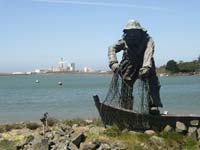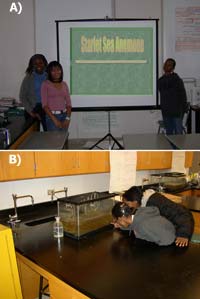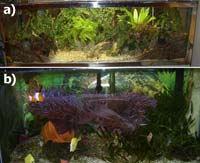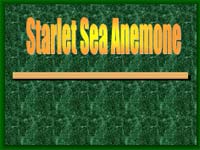Bringing the Urban Environment Into the Classroom: Learning From an Estuarine Mesocosm
by James C. Sullivan,¹ Theresa O'Neill,² and John R. Finnerty¹
¹ Biology Department, Boston University, 5 Cummington Street, Boston, MA 02135
² Odyssey High School, South Boston, MA
Abstract
As the United States and the world become increasingly urbanized, human populations exert a more concentrated impact on their local environments. The effects of human activity extend well beyond the geographical borders of cities, to almost every remote area. This worldwide urbanization has the additional impact of distancing urban youth from pristine habitats and making it difficult for them to connect with the natural world. This paper describes an inquiry-based educational unit that is designed for an environmental science class, biology class, or general science class and can be taught at a variety of grade levels (grades 6–12) with slight modification. In the unit, which supports National Science Education Standards (Appendix A), small groups of students observe an estuarine mesocosm. Each mesocosm is seeded with one common macroinvertebrate that inhabits urban salt marshes. Students research their organism through observation and literature review and present their findings to the rest of the class. The purpose of the unit is manifold: 1) to allow students to reconnect with the natural world; 2) to introduce the concept of adaptation to the urban biome; 3) to allow students to understand that many commonly encountered organisms may have economic or recreational benefits to human society as well as value independent of human concerns; and 4) to increase students' knowledge base regarding salt marsh ecosystems and the natural histories of four salt marsh–inhabiting organisms. Requiring the students to conduct independent research and report their findings to the class engages them in peer teaching and also forms a basis for formative and summative assessment. In addition, because the unit may require the use of multiple computer programs by the students, it reinforces or introduces the use of such tools in a format that is likely to maintain their interest.
Key words: urban ecology, lesson plan, secondary school, education, starlet sea anemone, banded killifish, grass shrimp, periwinkle
Introduction
As of April 1, 2000, 79% of Americans lived in urban environments (U.S. Census Bureau, 2002). Worldwide, urban populations are growing rapidly, in both absolute and relative terms. The percentage of the world's population living in urban areas is expected to rise to 58% by 2020 (McDevit, 1996). The recent increase in density and size of urban areas is attributed to increased fertility, decreased mortality, and population redistribution. As the United States and the world become increasingly urbanized, human populations exert a more concentrated impact on their local environments. The effects of human activity extend well beyond the geographical borders of cities, to almost every remote area. This worldwide urbanization has the additional impact of distancing urban students from pristine habitats and making it difficult for them to connect with the natural world.
It is imperative that students be introduced to urban ecology as part of an environmental science or biology curriculum. Urban students are already superficially familiar with the urban biome through their own experience. An academic investigation of this familiar biome provides an opportunity to teach many fundamental concepts of biology and environmental science. In this way, this lesson in urban ecology exemplifies a "place-based education" schema. The lesson can easily be integrated as a curriculum piece in an ecology, biology, or environmental-science class. Teaching students about the natural histories and biology of urban organisms helps them to understand biological concepts that extend well beyond those organisms (for example, the challenges of maintaining homeostasis in an urban aquatic environment). Teaching students about how organisms adapt to the urban biome, such as through pollution resistance, provides a natural transition into population genetics, Hardy-Weinberg equilibrium, and evolution in a broader sense. In addition, showing the economic or recreational benefits of certain organisms allows students to understand how many environmentalists and environmental economists support conservation interests (Cropper & Oates, 1992).
This lesson unit serves as a venue for open dialogue about the philosophical value of ecosystems and the organisms they harbor. Numerous researchers have argued that biophilia (and its corollary, personal environmental responsibility) is a direct result of bonding with natural systems and organisms during childhood (Flicker, 2002; Kellert & Wilson, 1993). This connection with the natural world is difficult for urban children to forge (Pyle, 2002). In addition to its science content, this unit is designed to encourage students to reconnect with, and foster stewardship for, the natural world (Pyle, 2003).
Estuaries often provide nearby cities with protected harbors as well as inland access through rivers (Figure 1), which makes these habitats particularly susceptible to the dangers of human population. According to a 1999 population census, six of the ten largest urban areas worldwide are located on estuaries (Table 1). Their high productivity, the temporal and spatial variability in salinity, water depth, and temperature (Nixon & Oviatt, 1973; Roman, Jaworski, Short, Findlay & Warren, 2000), in conjunction with high rates of human disturbance, makes estuaries an ideal candidate for an urban ecology lesson.
In the lesson, groups of students observe mesocosms of a salt marsh environment. Each group is assigned one organism (killifish, Fundulus heteroclitus; starlet sea anemone, Nematostella vectensis; grass shrimp, Palaemonetes pugio, or periwinkle, Littorina species). The assigned organism is seeded in the group's mesocosm, and students observe the organism and conduct independent research. The students then present their findings to the rest of the class, with particular emphasis on the pressures of living in urban environments and the adaptations that might allow these species to thrive in them. Students are challenged to describe the value of each organism: its value to human society and its intrinsic value. A prepared reference sheet about each organism (Appendices C–F) may be given to the students at the discretion of those implementing this lesson. By requiring a presentation, this unit allows students to develop observational, literature-research, and presentation skills.
This inquiry-based unit follows the National Science Education Standards (Appendix A; National Research Council, 2000) and is designed to actively engage students by allowing them to pursue their own questions as well as those posed by the instructor(s).
The lesson is written for urban classes that have access to a salt marsh from which to remove sediment and sample for organisms. However, it may be easily modified to accommodate schools without easy access to a salt marsh: The animals used in the lesson can be ordered from biological supply companies and housed in tanks containing dilute artificial seawater (e.g., Instant Ocean), with or without the addition of sediment. Alternatively, the lesson may be modified for aquatic or terrestrial mesocosms seeded with organisms from local biomes.
This curriculum was designed explicitly for the school and group of students for which it was piloted and is presented with details of its implementation, but educators can modify it to meet their own particular goals, both in terms of overall structure and detail. For example, while the use of the Internet for research and Microsoft PowerPoint for presentations is suggested here to increase the interdisciplinary value of this unit, educators can substitute other research methods or assessment techniques at their discretion.
The curriculum was designed in the summer and fall of 2004 and piloted in the fall of 2004 at Odyssey High School, South Boston, Massachusetts, in two classes (Figure 2). Odyssey High School is a racially heterogeneous (Table 2) urban public high school with diverse learners.
Prerequisite Knowledge and Skills
Prior to coming into this unit, students should acquire a basic working knowledge of their urban environment through maps, walking tours, discussion of local history, and introductory biology lessons. They should understand that every habitat has been affected in some way by anthropogenic disturbance, but that despite the human impacts, urban areas may harbor a high biomass. Students should have a rudimentary knowledge of estuarine environments in general and the role that salinity fluctuation plays in shaping the diversity in them. Familiarity with the Internet and Microsoft PowerPoint is helpful; otherwise, this lesson can be combined with an introduction to these tools.
New Learning for Students
The content of new material the students will learn follows:
A. Specific Content
Students will learn the i) habitat, ii) range, iii) life cycle, and iv) natural history of the following organisms, which are common inhabitants of both pristine and heavily disturbed salt marshes/estuaries:
- Banded killifish (Fundulus heteroclitus)
- Starlet sea anemone (Nematostella vectensis)
- Grass shrimp (Palaemonetes pugio)
- Periwinkle snail (Littorina species)
Each small group of students will become content expert on one species. Upon completion of observational and literature research, peer-to-peer teaching will be used to share findings and form the basis for evaluation.
B. Skills
Through implementation of this unit, students will learn to frame scientific questions, construct a mesocosm, perform careful observations, record data, review scientific literature, and present scientific findings.
C. Concepts
Students will learn that many pressures, including human disturbances such as habitat destruction and pollution, threaten the survival of urban organisms. The lesson will illustrate both common and unique strategies for survival in response to these disturbances. The effect of invasive species upon ecosystems will also be examined. Students will also learn that many organisms influence the economic or recreational value of urban environments (Cropper & Oates, 1992).
Performance Objectives
- Each group of students will create a mesocosm using water and sediment removed from a salt marsh pool.
- Each group of students will perform background research and assemble a presentation using Microsoft PowerPoint software on the organism they have been assigned. This presentation will include the following content:
- Title slide
- Natural history information
- Observations
- Content specific to urban ecology:
- How the organism is affected by/survives in spite of human disturbance
- The value of the organism intrinsically and to human society
- At least two original interesting facts on or aspects of the organism "discovered" by the group during its research.
In addition, each group will give a "tour" of its mesocosm to the other students in the class. As an alternative to the use of PowerPoint, a presentation using printed or hand-drawn transparencies or poster presentations may also be appropriate.
- During the presentation, groups will be expected to competently answer questions posed by other students and the instructor(s).
Materials
Materials are as follows:
- Salt marsh picture(s) (Figure 1)
- Mesocosm picture(s) (Figure 3)
- Ten-gallon aquarium per group
- Water aerators
- Five-gallon buckets
- Waders
- Shovel
- Salt marsh brackish water or Instant Ocean artificial seawater
- Project introduction sheet (Appendix B)
- Fact sheets for each organism (Appendices C–F), including a list of active websites for Internet research
- Computers with Microsoft PowerPoint software
- Projector and screen for student presentations
Procedure
Part I: Introduction to the Unit
This introduction requires two 50-minute classes. Time may be saved if students are not required to conduct the sampling, or if sediment is not included as part of the lesson.
The lesson begins with a highly engaging topic: mud. Literally and figuratively, sediment forms the base of the mesocosm. Mud is an engaging place to begin the discussion because most students will enter the class with the preconceived notion that mud is "gross." The students will likely be surprised to learn of its complexity and its importance in a functioning estuarine ecosystem.
- Students are given the opportunity to view, smell, and feel a sample of highly organic sediment, though they should not be forced to smell or touch it if they don't want to (Bixler & Floyd, 1999). The instructor(s) should be aware of the quality of the sediment and ensure that all proper safety precautions are taken if the sediment is likely to be contaminated.
- The belief that odorous sediment is "dirty" and indicates an unhealthy ecosystem should be drawn out conversationally. Questions (to ask students): "What do you think of the smell?" "Does the fact that it smells gross mean that the pool/river from which it came is unhealthy? Polluted? Dead?" (Explanations: "The highly organic nature of the sediment is responsible for the odor. The sediment is full of decomposing plants and animals," etc.)
- After students understand the reason for the odor of the sediment, introduce the concept of a mesocosm, and provide a picture(s) of examples (Figure 3). Tie in the sediment to the picture of a mesocosm and explain that they will be developing a mesocosm of a salt marsh pool.
- Explain the purpose and scope of the unit, providing a time line for the students if possible.
- Brainstorm with the students to develop a list of both biotic and abiotic factors that influence the biodiversity of a salt marsh ecosystem. Make sure that students are aware that their mesocosms will contain only a small subset of the organisms that inhabit the salt marsh.
- Formalize the list of biotic and abiotic elements of the salt marsh ecosystem. Students may be assigned homework to research and define each of these elements.
- Brainstorm with the students to create a materials list and a procedure for sampling the sediment.
- Formalize the materials list and procedure.
Part II: Development of Unit
Four to six 50-minute classes will be necessary for the development of the project. Class time dedicated to the project may be reduced by requiring the students to perform work outside class hours.
At this point, the students understand what a mesocosm is; they have compiled a materials list and created a written procedure; and they know the purpose of the unit. Once any needed parental permissions have been obtained, they are ready to go to the field site.
The development of the lesson follows:
- Students are taken to an appropriate field site. They should be divided into groups and briefed on what to expect beforehand to ensure that their educational experience in the field is not compromised by poor behavior or distractions (Crimmel, 2003). The collection site's water should have a salinity of between 5 and 15 parts per thousand (‰) to ensure survival of the species to be studied. Students are instructed to make observations about the pool from which the sediment is to be drawn and record any life forms spotted in or around the pool in their individual notebooks. They will also measure and record the water-column depth.
An instructor enters the pool (wearing hip or chest waders) and removes sediment using a shovel. (This step will require an instructor with sufficient dexterity and strength. He/she should be aware of the proper safety precautions for the particular type of waders being utilized.) Sediment is collected in a five-gallon bucket.
Additional five-gallon buckets are filled with brackish water on site by the instructor or, preferably, by the students (safety and individuals' ability permitting).
Alternatively, if a field site visit is precluded, artificial seawater can be prepared by the instructor with a salinity of between 5‰ and 15‰. - Sediment and water samples are brought back to the classroom or laboratory. Each student group lines the base of an aquarium with about three inches of sediment. Water from the field site (or artificial seawater) is then added to a depth of about seven to ten inches. A small aerator can be placed in each aquarium.
- Before distributing the organisms (collected from the field or ordered) to students, the instructor engages them in a discussion of the intrinsic value of the organisms. If the organisms are collected from the field, appropriate accommodations must be made to house the organisms at the conclusion of the lesson. (Note: Some Littorina species are not native to North American estuaries and have invasive tendencies, and Nematostella vectensis may also be nonnative. Do not release these animals into the wild, even if they were collected from a local estuary.)
If they are ordered from a supplier, the instructor must be prepared to maintain the developed mesocosms. The importance of making these accommodations is discussed with the students to ensure that they realize they are stewards of their mesocosms.
Each group is given one (or preferably more) specimen of one type of organism to study. The specimen(s) is distributed to each group in a 50 ml conical tube or some other small clear container. Ask the students to make observations about the organisms in the tubes, where they can view them in more detail than later, when the animals are in their larger environs.
At this point, ask students questions such as "What does the organism breathe? How does the organism breathe?" These types of general questions will help focus the students on looking at systems (i.e., respiratory) analogous to their own, and will also dovetail later on with urban environmental threats (i.e., deoxygenation through anthropogenic eutrophication).
Do not hand out the fact sheets yet. Allow students to formulate and record their own questions about the organisms. Later, they will research these questions. - After sufficient observation (less than 15 minutes), allow the students to place the organisms in the tanks. (Note: Before the class starts, make sure the water in the aquarium and the containers holding the organisms are roughly equal in temperature.) If using the fact sheets (Appendices C–F), hand out them out and allow the rest of the period for observations and independent reading. Depending upon the scope of inquiry the instructor wants to foster, he or she might consider not using these fact sheets at all and allowing all research and direction to be driven by the students.
- During the next class, allow the assigned groups to organize their time, and if possible, provide students access to computers. Each student should have read the fact sheet on the organism the group has been assigned as homework or during the class before. The group needs to:
- Conduct research (Internet, library, interviews of scientists) on the research questions/guidelines for the presentation and questions posed by the students themselves
- Continue to make observations of the organisms
- Develop a presentation
Part III: Closure of Unit
Lectures or discussions of the pressures upon organisms in urban environments are presented, specifically addressing their adaptations to survive in an urban ecosystem, and students should be introduced to the idea of stewardship. To conclude the unit, students make a presentation on their mesocosm, which includes accepting and answering questions formulated by both other students and their instructor(s). A final homework sheet may be handed out to the students to gauge the effectiveness of the lesson and to be used in student evaluation.
Evaluation
Throughout the project, the instructor challenges the students informally with questions to check student interest and encourage participation. Students are graded on their presentation based on written guidelines established by the individual educators and their school systems. The instructor can direct the questions during the presentation toward specific group members to aid in individual evaluation. Individual evaluation can be further determined by self-evaluations or group-peer evaluations. A homework sheet can also be used for evaluation.
Anecdotal Results From the Lesson Pilot
While resource constraints precluded us from piloting this lesson plan in more than one school, we qualitatively found that the lesson was successful at engaging students and teaching the prescribed content. Students were surprised and intrigued by the organisms, particularly because many of them had believed that there was nothing alive in the urban estuary from which our samples were collected. There was much variation in the quality of the concluding presentations (see Figure 4 for an example of a student presentation).
Follow-up Lessons
The presence of these organisms in the classroom/laboratory allows the opportunity to teach many other aspects of biology and environmental science. Discussions of population genetics and evolution naturally follow from discussion of adaptive resistance to toxins, which is particularly well supported in the case of Fundulus (Oleksiak, Churchill & Crawford, 2002; Elskus, Monosson, McElroy, Stegeman & Woltering, 1999). Interspecific competition can be illustrated between F. heteroclitus and P. pugio (Cross & Stiven, 1997). Morphology of bilaterians and radially symmetrical animals can be discussed in the context of Nematostella vectensis (Finnerty, 2003; Martindale, Finnerty & Henry, 2002). The same species can be used to lead an inquiry-based lesson on regeneration and/or asexual reproduction (Hand & Uhlinger, 1992; for this lesson plan see http://www.nematostella.org/Resources_Classroom_JS02.html). Other basic biology lessons utilizing this organism may be retrieved from http://www.nematostella.org/Resources_Classroom.html. Allopatric speciation can be discussed in reference to habitat fragmentation. The effects of invasive species can be illustrated by the extremely successful Littorina family, especially in reference to the role of humans in their dispersal (Bertness, 1984; Brenchly & Carlton, 1983).
This list of follow-up lessons is not exhaustive. Perhaps the best follow-up lessons will be those devised by students. Having aquariums in the classroom allows students to design controlled experiments to test many hypotheses. A few suggestions include predator/prey interaction experiments, growth-rate experiments, and niche-partitioning experiments.
Acknowledgments
This work was funded by a GK12 grant from the National Science Foundation (NSF DGE-0231909) designed to enrich high school curriculum in science, technology, engineering, and math by partnering graduate students in classrooms with K–12 teachers. Additional support was provided through a National Science Foundation grant (IBN-0212773) to John R. Finnerty. We thank Jean Francoise for assistance with animal collection and Cynthia Brossman, Lance Pearson, and three anonymous reviewers for insightful comments regarding both the scientific content and educational merit of the lesson plan.




